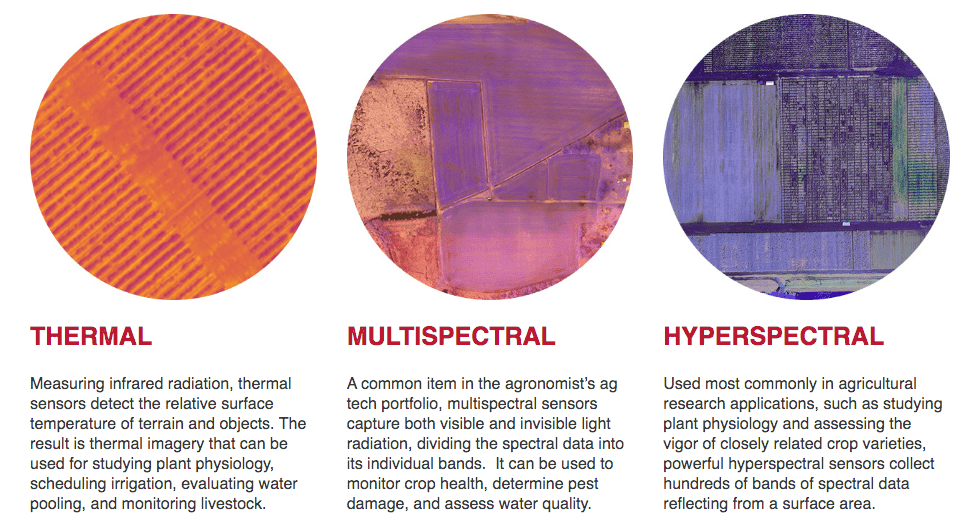Mounted to drones, today’s advanced sensor technology has the ability to capture rich, detailed crop and livestock data. Data farmers, agronomists, and crop insurers can use to solve important problems and make more informed decisions. Data that helps agrochemical and seed companies improve their products, reduce costs, and increase efficiencies.
Today’s drone-based sensors are smaller, lighter, more powerful and often more specialised than previous, aircraft-based versions. They can capture various types of data in high-resolution, helping to make your aerial intelligence efforts easier, safer, and more efficient than ever before.
Skyspec’s drones can be used for a wide variety of applications such as:
Assessment of plant greenness or photosynthetic active biomass (which might correlate to nitrogen)
Crop stress (for irrigation or other management)
Weed stress (for fallow spraying)
Insect activity (hot spots)
Crop maturity or ripeness (for harvest or desiccation)
Assessment of soil colour and ground cover
Yield estimation
3D mapping for land levelling or development

NDVI- Normalised Differential Vegetation Index
As plants become healthier, the intensity of reflectance increases in the NIR and decreases in the Red, which is the physical basis for most vegetation indices. NDVI values can be a maximum value of 1, with lower values indicating lower plant vigor. Therefore, 0.5 typically indicates low vigor whereas 0.9 indicates very high vigor. NDVI is also effective for distinguishing vegetation from soil. NDVI is recommended when looking for differences in above-ground biomass in time or across space. NDVI is most effective at portraying variation in canopy density during early and mid development stages but tends to lose sensitivity at high levels of canopy density.
Uses
plant vigor
differences in soil water availability
foliar nutrient content (when water is not limiting)
yield potential
CIR Composite -Color Infrared
This layer is a color composite and not an Index. It is referred to as a Color Infrared Composite because instead of combining Red, Green, and Blue bands (which is the standard image display method you are accustomed to) we are combining NIR, Red, and Green bands. NIR light is displayed as red, red light is displayed as green, and green light is displayed as blue (R: NIR, G: RED, B: GREEN). This color composite highlights the response of the Near-infrared band to crop health and water bodies.
Healthy vegetation reflects a high level of NIR and appears red in CIR layers. Unhealthy vegetation will reflect less in the NIR and appear as washed out pink tones, very sick or dormant vegetation is often green or tan, and man-made structures are light blue-green. Soils may also appear light blue, green, or tan depending on how sandy it is, with sandiest soil appearing light tan and clay soils as dark tan or bluish green. This is also highly useful in identifying water bodies in the imagery, which absorb NIR wavelengths and appear black when water is clear. Since this is not an index, as stated above, there is no colour palette to select. The colours you see are a result of additive mixture of NIR, Red, and Green wavelengths at each image pixel.
Uses
assessing plant health
identifying water bodies
variability in soil moisture
assessing soil composition
NDRE (Normalized Difference Red Edge)
NDRE is an index that can only be formulated when the Red edge band is available in a sensor. It is sensitive to chlorophyll content in leaves (how green a leaf appears), variability in leaf area, and soil background effects. High values of NDRE represent higher levels of leaf chlorophyll content than lower values. Soil typically has the lowest values, unhealthy plants have intermediate values, and healthy plants have the highest values. Consider using NDRE if you are interested in mapping variability in fertilizer requirements or foliar Nitrogen, not necessarily Nitrogen availability in the soil.
Chlorophyll has maximum absorption in the red waveband and therefore red light does not penetrate very far past a few leaf layers. On the other hand, light in the green and red-edge edge can penetrate a leaf much more deeply than blue or red light so a pure red-edge waveband will be more sensitive to medium to high levels of chlorophyll content, and hence leaf nitrogen, than a broad waveband that encompasses blue light, red light, or a mixture of visible and NIR light (e.g. a modified single-imager camera).
NDRE is a better indicator of vegetation health/vigor than NDVI for mid to late season crops that have accumulated high levels of chlorophyll in their leaves because red-edge light is more translucent to leaves than red light and so it is less likely to be completely absorbed by a canopy. It is more suitable than NDVI for intensive management applications throughout the growing season because NDVI often loses sensitivity after plants accumulate a critical level of leaf cover or chlorophyll content.
Uses
leaf chlorophyll content
plant vigor
stress detection
fertilizer demand
Nitrogen uptake
Contact Skyspec today to talk about your agriculture needs.
We’re always pleased to provide you with a quote but bear in mind that before we accept any job and sometimes before we can provide an appropriate quote, we may need to ask you some questions. There are many regulations that apply to the operation of RPAS (remotely piloted aircraft systems). we’re required by CASA to ensure that we at all times operate in a manner that is safe and legal.
